
(a)
The equivalent resistance of the circuit given.
(a)
Answer to Problem 60AP
The equivalent resistor of the circuit is
Explanation of Solution
Following figure shows the resistance connected a voltage source of
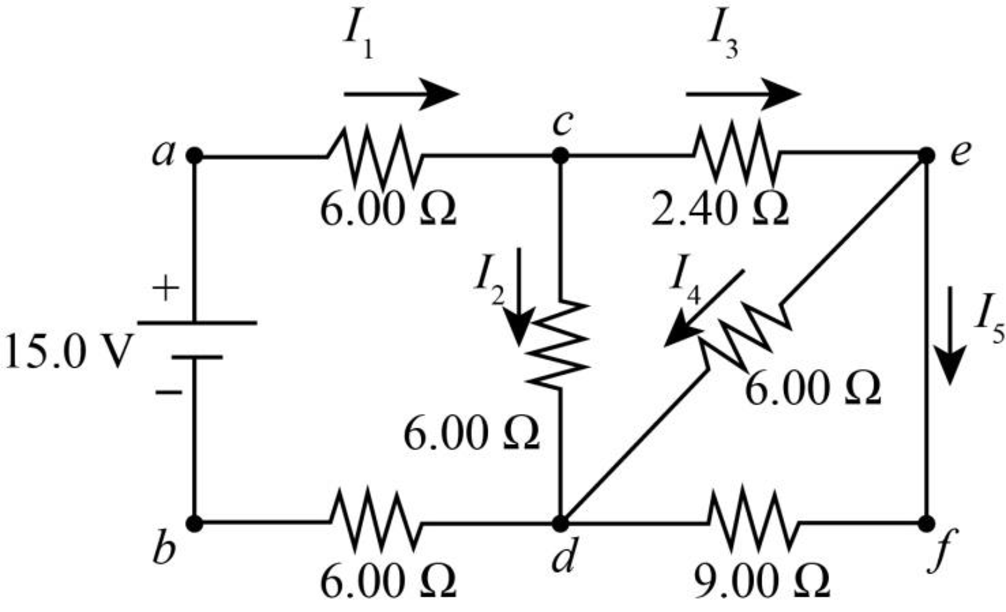
Figure-(1)
Write the expression for equivalent resistance connected in parallel.
Here,
Write the expression for equivalent resistance connected in series.
Here,
Following figure shows the rearranged circuit of the system from Figure (1) for better understanding.
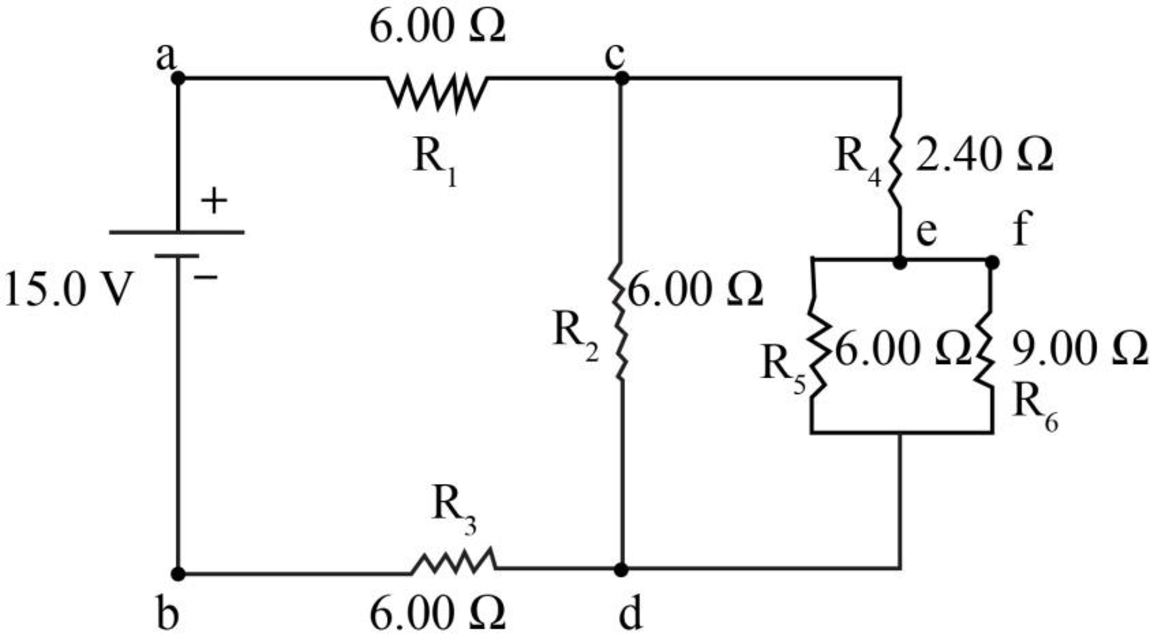
Figure-(2)
Conclusion:
From figure (2) calculate the equivalent resistance for
Substitute
Following figure shows the reduced circuit for the above equivalence.
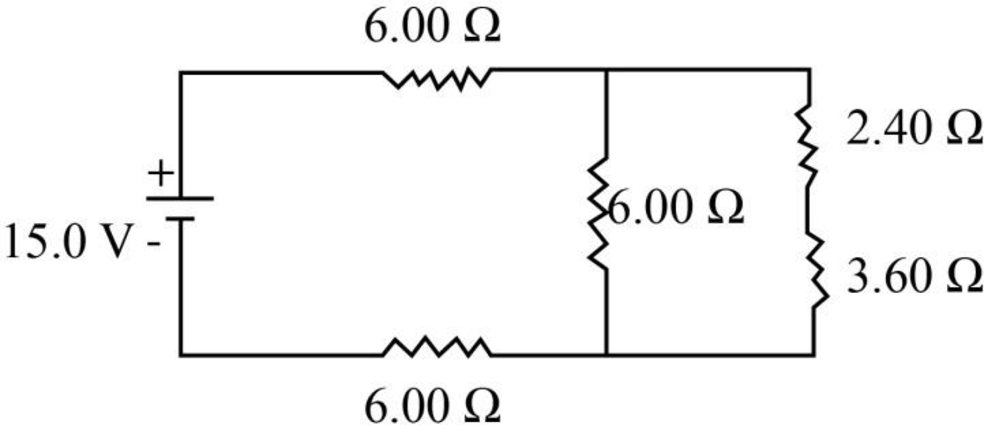
Figure-(3)
From figure (3) calculate the equivalent resistance for
Substitute
Following figure shows the reduced circuit for the above equivalence.
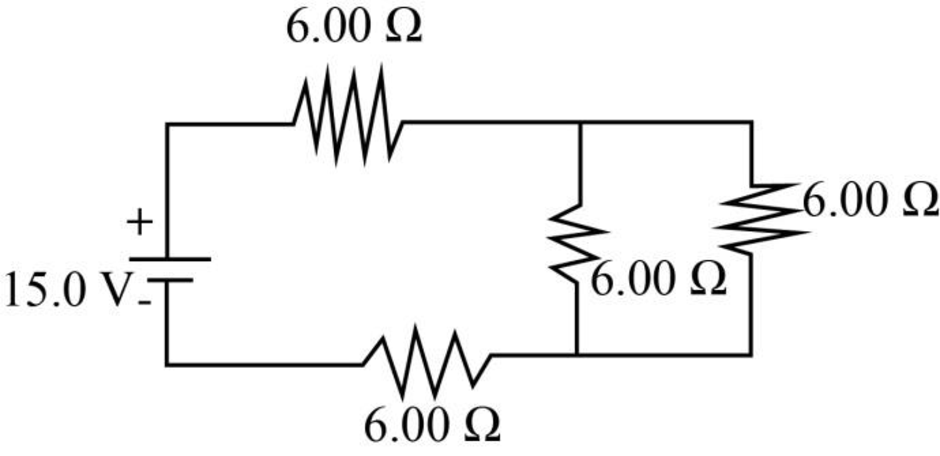
Figure-(4)
From figure (4) calculate the equivalent resistance for
Substitute
Following figure shows the reduced circuit for the above equivalence.
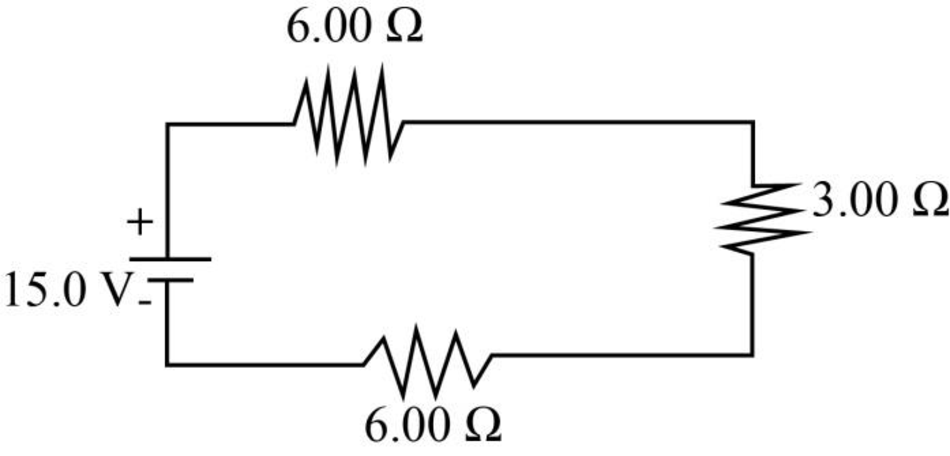
Figure-(5)
From figure (5) calculate the equivalent resistance for
Substitute
Therefore the equivalent resistor for the circuit is
(b)
The potential difference across each resistor.
(b)
Answer to Problem 60AP
voltage between junctions
Explanation of Solution
Write the expression for potential difference between two points of a resistor.
Here,
Conclusion:
Substitute
Calculate voltage drop across each
Substitute
Calculate voltage drop across
Substitute
Calculate current through
Substitute
Calculate voltage drop across
Substitute
Calculate the voltage drop across
Substitute
Therefore, voltage drop across the parallel resistor
Therefore, voltage between junctions
(c)
The each current indicated in the circuit.
(c)
Answer to Problem 60AP
ThecCurrent
Explanation of Solution
Rewrite Equation (III) to calculate
Conclusion:
Substitute
Substitute
Substitute
Substitute
Substitute
Therefore, current
(d)
The power delivered to each resistor.
(d)
Answer to Problem 60AP
Power delivered to resistor
Explanation of Solution
Write the expression for power in resistor.
Here,
Conclusion:
Substitute
Substitute
Substitute
Substitute
Substitute
Substitute
Therefore, power at resistor
Want to see more full solutions like this?
Chapter 28 Solutions
Bundle: Physics for Scientists and Engineers with Modern Physics, Loose-leaf Version, 9th + WebAssign Printed Access Card, Multi-Term
- Please solve and answer this problem correctly please. Thank you!!arrow_forwardYou're on an interplanetary mission, in an orbit around the Sun. Suppose you make a maneuver that brings your perihelion in closer to the Sun but leaves your aphelion unchanged. Then you must have Question 2 options: sped up at perihelion sped up at aphelion slowed down at perihelion slowed down at aphelionarrow_forwardThe force of the quadriceps (Fq) and force of the patellar tendon (Fp) is identical (i.e., 1000 N each). In the figure below angle in blue is Θ and the in green is half Θ (i.e., Θ/2). A) Calculate the patellar reaction force (i.e., R resultant vector is the sum of the horizontal component of the quadriceps and patellar tendon force) at the following joint angles: you need to provide a diagram showing the vector and its components for each part. a1) Θ = 160 degrees, a2) Θ = 90 degrees. NOTE: USE ONLY TRIGNOMETRIC FUNCTIONS (SIN/TAN/COS, NO LAW OF COSINES, NO COMPLICATED ALGEBRAIC EQUATIONS OR ANYTHING ELSE, ETC. Question A has 2 parts!arrow_forward
- The force of the quadriceps (Fq) and force of the patellar tendon (Fp) is identical (i.e., 1000 N each). In the figure below angle in blue is Θ and the in green is half Θ (i.e., Θ/2). A) Calculate the patellar reaction force (i.e., R resultant vector is the sum of the horizontal component of the quadriceps and patellar tendon force) at the following joint angles: you need to provide a diagram showing the vector and its components for each part. a1) Θ = 160 degrees, a2) Θ = 90 degrees. NOTE: USE DO NOT USE LAW OF COSINES, NO COMPLICATED ALGEBRAIC EQUATIONS OR ANYTHING ELSE, ETC. Question A has 2 parts!arrow_forwardNo chatgpt pls will upvotearrow_forwardThe force of the quadriceps (Fq) and force of the patellar tendon (Fp) is identical (i.e., 1000 N each). In the figure below angle in blue is Θ and the in green is half Θ (i.e., Θ/2). A) Calculate the patellar reaction force (i.e., R resultant vector is the sum of the horizontal component of the quadriceps and patellar tendon force) at the following joint angles: you need to provide a diagram showing the vector and its components for each part. a1) Θ = 160 degrees, a2) Θ = 90 degrees. NOTE: USE ONLY TRIGNOMETRIC FUNCTIONS (SIN/TAN/COS, NO LAW OF COSINES, NO COMPLICATED ALGEBRAIC EQUATIONS OR ANYTHING ELSE, ETC. Question A has 2 parts!arrow_forward
- ་ The position of a particle is described by r = (300e 0.5t) mm and 0 = (0.3t²) rad, where t is in seconds. Part A Determine the magnitude of the particle's velocity at the instant t = 1.5 s. Express your answer to three significant figures and include the appropriate units. v = Value Submit Request Answer Part B ? Units Determine the magnitude of the particle's acceleration at the instant t = 1.5 s. Express your answer to three significant figures and include the appropriate units. a = Value A ? Unitsarrow_forwardSolve and answer the question correctly please. Thank you!!arrow_forwardSolve and answer the question correctly please. Thank you!!arrow_forward
 Physics for Scientists and Engineers, Technology ...PhysicsISBN:9781305116399Author:Raymond A. Serway, John W. JewettPublisher:Cengage Learning
Physics for Scientists and Engineers, Technology ...PhysicsISBN:9781305116399Author:Raymond A. Serway, John W. JewettPublisher:Cengage Learning Physics for Scientists and Engineers: Foundations...PhysicsISBN:9781133939146Author:Katz, Debora M.Publisher:Cengage Learning
Physics for Scientists and Engineers: Foundations...PhysicsISBN:9781133939146Author:Katz, Debora M.Publisher:Cengage Learning College PhysicsPhysicsISBN:9781305952300Author:Raymond A. Serway, Chris VuillePublisher:Cengage Learning
College PhysicsPhysicsISBN:9781305952300Author:Raymond A. Serway, Chris VuillePublisher:Cengage Learning College PhysicsPhysicsISBN:9781285737027Author:Raymond A. Serway, Chris VuillePublisher:Cengage Learning
College PhysicsPhysicsISBN:9781285737027Author:Raymond A. Serway, Chris VuillePublisher:Cengage Learning Principles of Physics: A Calculus-Based TextPhysicsISBN:9781133104261Author:Raymond A. Serway, John W. JewettPublisher:Cengage Learning
Principles of Physics: A Calculus-Based TextPhysicsISBN:9781133104261Author:Raymond A. Serway, John W. JewettPublisher:Cengage Learning





